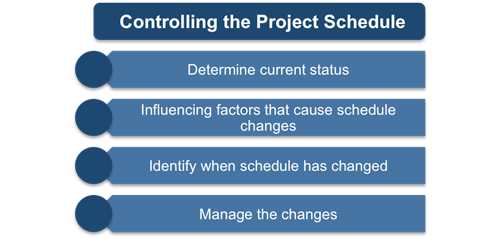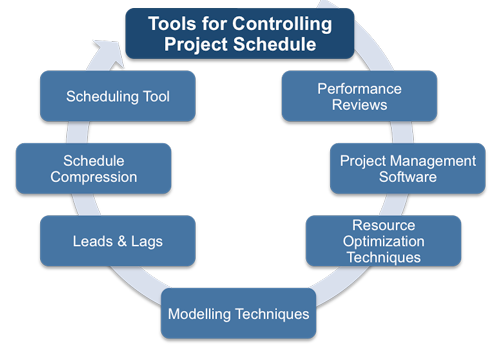Controlling the Project Schedule
A schedule baseline is needed if the schedule is going to be controlled and this baseline must be maintained so that it reflects the current status of the project.
 |
This process is part of monitoring and controlling and is sometimes referred to as 'working the plan' in contrast with the previous processes which are all to do with 'planning the work'. Controlling the schedule involves:
1) Determining the current status
2) Influencing factors that could cause schedule changes
3) Identifying if the schedule has changed
4) Managing changes as they occur
There are several different techniques that can be used to control the project schedule.
Performance reviews measure, compare, and analyze schedule performance such as actual start and finish dates, percent complete, and the remaining duration for work in progress. If earned value management (EVM) is utilized the schedule variance and schedule performance index are used to assess the magnitude of schedule variations.
An important part of schedule control is to decide if the schedule variation requires corrective action. For example, a major delay on any activity not on the critical path may have little effect on the overall project schedule, while a much shorter delay on a critical or near-critical activity may require immediate action.
If using the critical chain scheduling method, comparing the amount of buffer remaining to the amount of buffer needed to protect the delivery date can help determine schedule status. The difference between the buffer needed and the buffer remaining can determine whether corrective action is appropriate.
Schedule performance measurements are used to assess the magnitude of variation to the original schedule baseline. The total float variance is also an essential planning component to evaluate project time performance.
Important aspects of project schedule control include determining the cause and degree of variance relative to the schedule baseline and deciding whether corrective or preventive action is required.
 |
Adjusting leads and lags is used to find ways to bring project activities that are behind into alignment with plan.
The schedule compression techniques described earlier are used to find ways to bring project activities that are behind into alignment with the plan. It includes crashing, which adds resources and fast-tracking, in which activities normally done in sequence are now performed in parallel for part of their duration.
Schedule data is updated and compiled into the schedule to reflect actual progress of the project and remaining work to be completed. The scheduling tool and the supporting schedule data are used in conjunction with manual methods or other project management software to perform schedule network analysis to generate an updated project schedule.
The most crucial outputs are the work performance information in the form of: Schedule variance (SV) and Schedule performance index (SPI).
These can be used to forecast future performance of the project based on the performance to date. If this information indicates that there is a significant variance of the performance of the project as compared to the performance baseline, then this may suggest changes to either the project itself in the form of corrective action or preventive action, or changes to the schedule baseline itself if it is determined that the original baseline was unrealistic.
Any of these change requests are then fed as inputs into the change control process. If there is an eventual change to the schedule baseline, then that will generate a new project schedule. If schedule compression techniques are used, this may create changes in other management areas: cost (in the case of crashing) and risk (in the case of fast-tracking).
Finally, if the reason for the variances is uncovered, this is noted in the lessons learned so that further scrutiny can be given to this throughout the rest of the project. The following represent outputs from this process:
Measurements can include planned vs. actual technical performance or other scope performance measurements. This information is documented and communicated to stakeholders.
These are estimates of the future conditions of the project based on the work performance information provided.
Schedule variance analysis, along with review of progress reports, results of performance measures, and modifications to the project schedule can result in change requests to the schedule baseline and/or to other components of the project plan.
Change requests are processed for review and disposition through the change control process. Preventive actions may include recommended changes to reduce the probability of negative schedule variances.
Elements of the project plan that may be updated when variance occurs include:
1) The schedule baseline changes are incorporated in response to approved change requests related to project scope changes, activity resources, or activity duration estimates.
2) The schedule plan may be updated to reflect a change in the way the schedule is managed.
3) The cost baseline may be updated to reflect changes caused by compression or crashing techniques.
Project documents that may be updated when variance occurs include:
1) New project schedule network diagrams may be developed to display approved remaining durations and modifications to the work plan. In some cases, project schedule delays can be so severe that development of a new target schedule with forecasted start and finish dates is needed to provide realistic data for directing the work, and for measuring performance and progress.
2) An updated project schedule will be generated from the updated schedule data to reflect the schedule changes and manage the project.
3) Schedule compression or fast-tracking may generate new risks that should be documented in the risk register.
The importance of the project schedule cannot be under-estimated, its management plan is one of the key documents for any project manager. He or she will need to be vigilant in observing the communication of the latest version of the project schedule to ensure the executing phase runs as smoothly as possible.
You may also be interested in:
Managing the Project Schedule | Defining the Project Activities | Sequencing the Project Activities | Estimating the Resources Required | Estimating the Time Required | Developing the Project Schedule | Controlling the Project Schedule.
|
|


